- Quick Read
- Deep Read ( 6 Min. )

Why is Christian Science in our name?
Our name is about honesty. The Monitor is owned by The Christian Science Church, and we’ve always been transparent about that.
The Church publishes the Monitor because it sees good journalism as vital to progress in the world. Since 1908, we’ve aimed “to injure no man, but to bless all mankind,” as our founder, Mary Baker Eddy, put it.
Here, you’ll find award-winning journalism not driven by commercial influences – a news organization that takes seriously its mission to uplift the world by seeking solutions and finding reasons for credible hope.
Explore values journalism About usMonitor Daily Podcast
- Follow us:
- Apple Podcasts
- Spotify
- RSS Feed
- Download
TODAY’S INTRO
Life with The Clock: Play ball! But faster.
Jeremy Peña, star shortstop for the Houston Astros, looked stunned. He had just been called out on strikes without even receiving a final pitch – and that was precisely the problem. Mr. Peña had failed to be ready in time.
We in the stands at Florida’s Ballpark of the Palm Beaches were confused. “What just happened?” we wondered, if not verbally, at least with our eyes.
This, we soon realized, is life with The Clock – one of many new features and rules now in effect in professional baseball to speed things up and make the game more exciting.
To be blunt: The national pastime had gotten boring. Pitchers were taking forever to pitch. Batters were taking forever to settle in to actually, maybe, hit the ball. Games were dragging on and on. And owners were feeling it in the bottom line, with attendance in steady decline.
“Bring a good book,” I would advise anyone going to a game.
The Clock can be mesmerizing. There’s now a 30-second limit between batters. Pitchers have 20 seconds to pitch if there are runners on base, 15 seconds if not. Batters must be ready at home plate with eight seconds to go. If a pitcher violates The Clock, he’s charged an automatic ball. An unready batter gets an automatic strike.
I found myself sometimes watching The Clock and not the actual players. But, like the players themselves, we’ll all soon get used to the new normal and ignore The Clock, as we do in professional basketball and football.
The impact has been immediate. Games are now, on average, a half-hour shorter. The Astros-Red Sox game we attended March 1 lasted a reasonable two hours and 26 minutes, albeit ending in an unsatisfying 4-4 tie. (No extra innings during spring training.)
So, kudos to Theo Epstein, the genius who helped both the once-benighted Boston Red Sox and Chicago Cubs overcome their “curses” and win the World Series. Mr. Epstein was hired by Major League Baseball to save the game itself, and through smart analysis and advice from focus groups, he may have succeeded.
And with that, play ball!
Share this article
Link copied.

Help fund Monitor journalism for $11/ month
Already a subscriber? Login

Monitor journalism changes lives because we open that too-small box that most people think they live in. We believe news can and should expand a sense of identity and possibility beyond narrow conventional expectations.
Our work isn't possible without your support.
Why Bakhmut battle is high stakes for all
Whether Russia or Ukraine wins the battle for Bakhmut, heavy casualties mean it will be a Pyrrhic victory. Russians are fighting for a symbol; Ukrainians are fighting for their home.
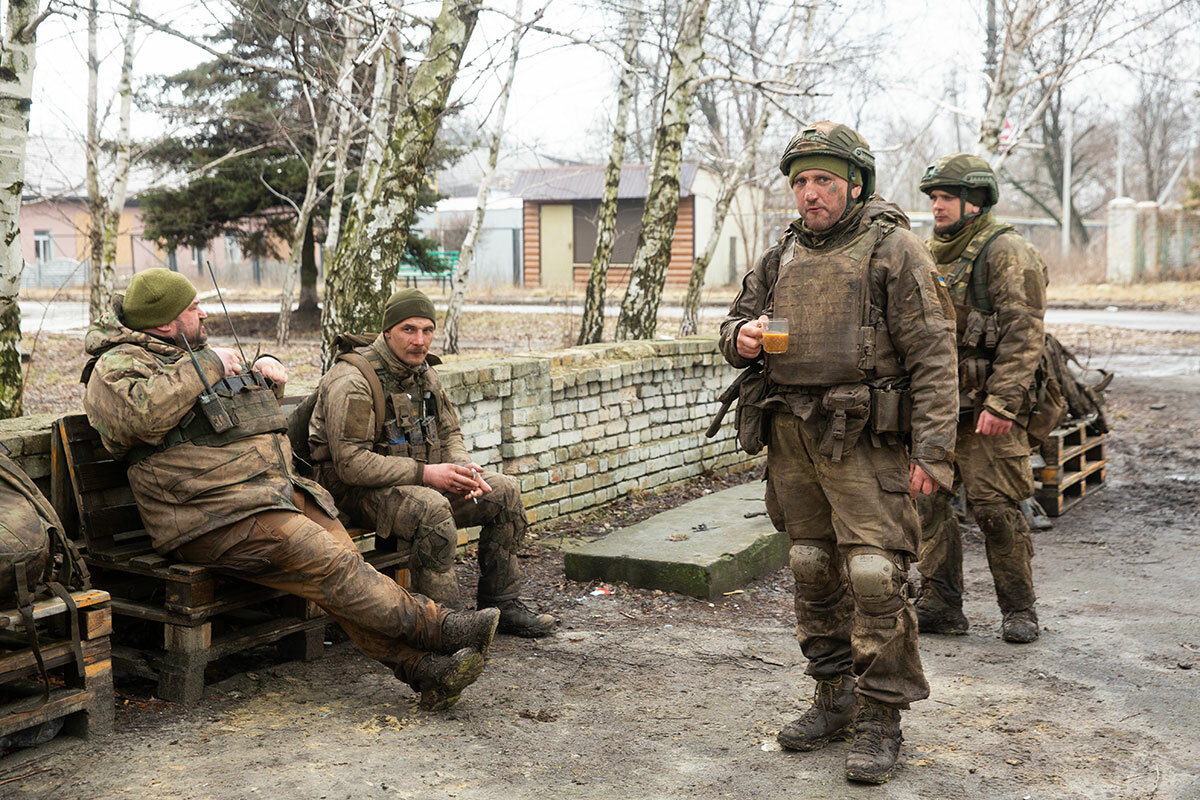
In crude military parlance, the eastern Ukrainian town of Bakhmut is a “meat grinder.”
Nobody knows how many Russian soldiers have died in Moscow’s long, drawn-out assault on Bakhmut, nor how many Ukrainians have died defending it. But the scale of the carnage can be judged by the words of one young Ukrainian soldier as he took a few hours of leave near the Bakhmut front this week.
“Russians got as close to us as 30 meters,” he said. “I’ve never seen so many people walking straight into the bullets, willing to die like that. Nothing prepared me to see such sights.”
Bakhmut has no great strategic importance, but Russian President Vladimir Putin is anxious for a military victory and has chosen to do whatever it takes to capture the town. By the same token, Ukrainian leader Volodymyr Zelenskyy feels he cannot surrender the place.
“All we can do by fighting with all our might is exact the highest price possible for each meter” that the Russians take, says Yan Antoniuk, a Ukrainian squad commander near Bakhmut.
Asked whether the town is worth such a high cost, he is blunt. “That is like asking whether you want to be a slave or not,” he says.
Why Bakhmut battle is high stakes for all
Leaning against a low wall in the shadow of a building large enough to provide cover from Russian shellfire, Mykhailo sips his tea with calm determination as he and fellow members of his unit await evacuation. For weeks, they have been defending Bakhmut against an intense Russian onslaught in a battle that has come to symbolize the savagery of the war in Ukraine.
Covered in mud and visibly exhausted, none of the men flinch or take cover when a mortar lands uncomfortably close. The fierce battle has subjected nearby towns such as Chasiv Yar, a few miles from the Bakhmut front line, to a constant barrage of tank shells, mortar rounds, and thundering Grad rockets.
“We are holding onto the city, but at what price?” wonders Mykhailo, a member of the Ukrainian army’s 77th brigade who shared only his first name. “The losses are huge. If we keep this city, who will walk in it? Just dogs?”
“The fighting has been hard all along,” says Sergiy, a soldier with honey-colored eyes brimming with tears. The men are in shock. One of their comrades was killed hours earlier in Bakhmut, the latest casualty in a battle that has been as long as it has been brutal, leaving the town almost completely destroyed after 10 months of fighting.
The soldiers know they have been risking their lives to hold positions of questionable strategic value. They find courage by channeling their anger against Russia over fallen comrades and atrocities committed in Ukraine, as well as the primal instinct to defend their homes and families.
Ukrainian President Volodymyr Zelenskyy, like the Russian army, has assigned great symbolic meaning to Bakhmut, making it a potential morale game changer for both camps.
Moscow covets full control of the industrial, coal-rich region known as Donbas in eastern Ukraine. That part of the country has been plunged into conflict since 2014, when Russian-backed separatists annexed large swathes of Ukrainian territory. Russian forces have taken over almost all of Luhansk since the full-scale invasion in 2022 and have gained new ground in Donetsk.
Russian forces, reportedly largely made up of fighters belonging to the mercenary Wagner Group, are closing in on Bakhmut, and the town has appeared on the verge of falling under complete Russian control for several days. The Ukrainian government fears such an outcome would open the road to larger cities such as Kramatorsk and Sloviansk.
That concern is reflected in newly reinforced checkpoints on intercity roads west of Bakhmut, and in the work of mechanical diggers on nearby hilltops, creating new defensive positions.
The Washington-based Institute for the Study of War, in a report Wednesday, estimated that Russian forces controlled about half of Bakhmut, but doubted whether the town’s eventual fall would lead to a rapid advance by Russian forces.

“Nothing prepared me”
Several miles further from Bakhmut, the war has turned a small gas station into a bustling hub for Ukrainian and foreign fighters rotating in and out of combat along the extensive front line. Its forecourt is packed with military vehicles refueling; its small shop crowded with soldiers stocking up on energy drinks and fast food.
A band of young soldiers rush to swallow their hot dogs before jumping back into their vehicle to return to Bakhmut. Clenched jaws replace ready smiles as they slip back into body armor and helmets.
“In the last 24 hours our position was attacked at least 10 times,” says Lt. Yuri Andriyaschenko, who once worked as a massage therapist. “Russians got as close to us as 30 meters. I’ve never seen so many people walking straight into the bullets, willing to die like that. About 20 at a time. Nothing prepared me to see such sights.”
He admits to being frightened but is careful not to let that show. The stakes are too high – Russian occupation would be worse than death, he says. But still, the act of killing troubles him. “It is morally hard to point a gun at a person, to kill a person,” he says. “I am doing that every day and that’s hard to do – even when I know that they want to kill me.”
Offering solace to men facing such agonizing choices is the Rev. Oleh Maksymets, who ushers all who stop at the filling station toward a table set with soup, cubes of pork fat (a Ukrainian favorite), and sweet pastries.
“Many people bring food, but it is also important to bring food for the soul,” says the chaplain, who used to hold services in prisons and now does so wherever he can on the front line: in trenches, in basements, and even at gas stations.
For him, the war in Ukraine is a great battle between good and evil. The images of children shot at point-blank range in Bucha, a small town outside Kyiv still haunt him. “It is very important to have a strong spirit to continue fighting,” he says.
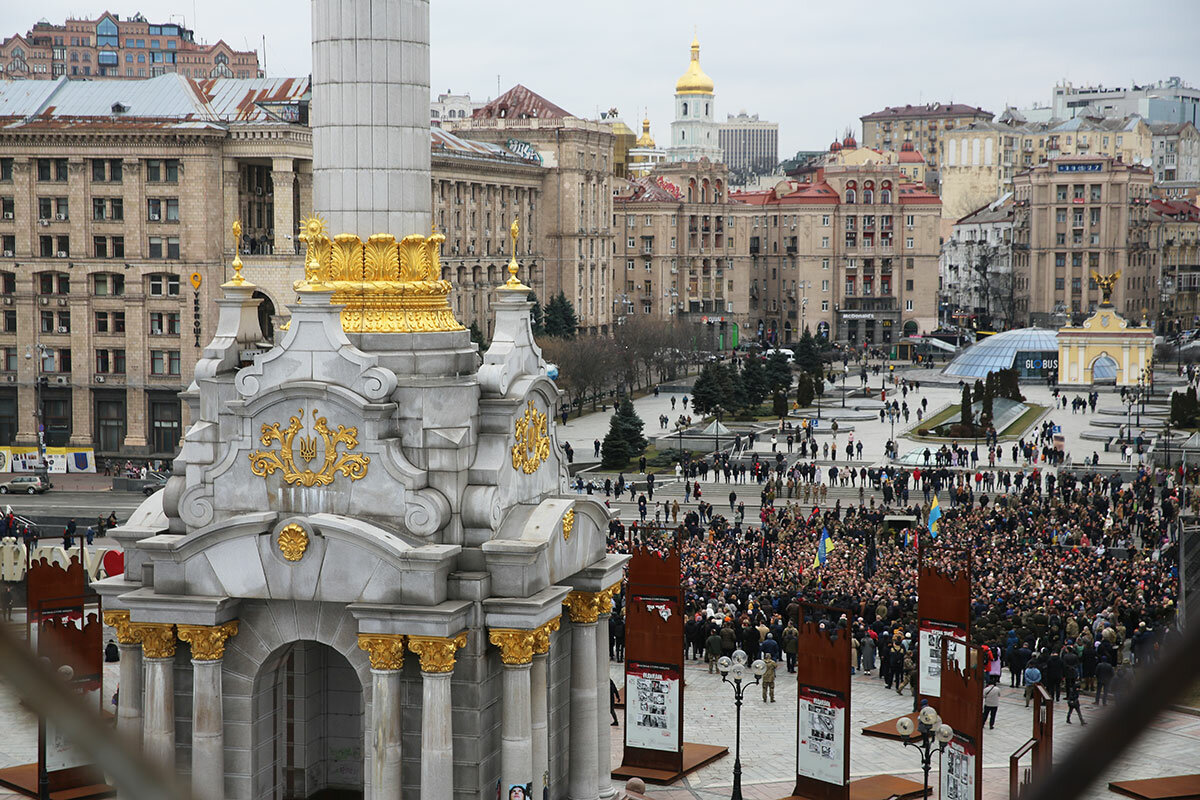
Pain and sacrifice
The pain and sacrifice of the front line made itself felt in the capital, Kyiv, on Friday as mourners buried a nationally famous military commander – one of the youngest to be awarded the Hero of Ukraine medal – who was killed near Bakhmut on Tuesday.
His bravery was captured in a final front-line image of him using a bucket of water to battle the flames of an ammunition-filled tank set ablaze by a Russian shell.
Thousands showed up to pay their respects to Lt. Dmytro Kotsiubailo, code-named Da Vinci. Among them was young mother Alisa Riazantseva, trying to keep track of her toddler Ivan in the crowd and shedding tears for the sacrifice of this fallen soldier.
“We feel enormous grief and pain because there are thousands like Da Vinci,” she said. “We are working on having another child because so many men and women are dying in this war.”
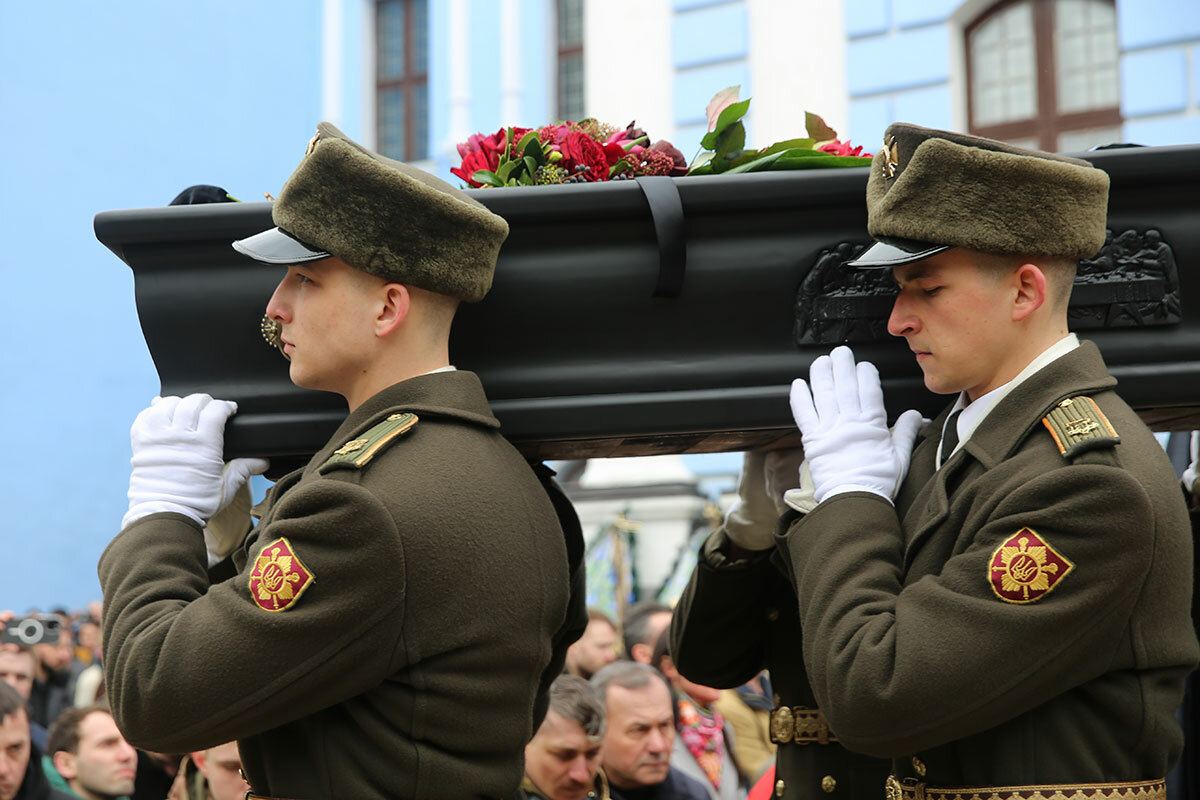
Neither Ukrainian nor Russian officials publish casualty figures, but in Bakhmut they are appalling. In the three days before Lieutenant Andriyaschenko set off for his new Bakhmut posting, he says, half of the 700 men in his battalion were either killed or wounded. It is hard for foot soldiers like him to decipher the strategic thinking of their superiors.
“We are holding onto Bakhmut but we are paying a high price,” he says. He summons the drive to fight on, he says, by thinking of the devastation that towns which have come under Russian control suffered. “Russian occupation is the scariest thing,” he says. “We cannot let that happen.”
Yan Antoniuk is a squad commander stationed on one of the main roads leading to Bakhmut. He is “almost sure” that Russian forces will eventually encircle the town. “We are outnumbered and outgunned,” he acknowledges. “The Russians are fighting and unfortunately advancing one meter a day. All we can do by fighting with all our might is exact the highest price possible for each meter. The casualties on both sides are massive.”
Asked whether Bakhmut is worth such a high cost, he is blunt. “That is like asking whether you want to be a slave or not,” he says. “It all comes down to a village, a town, a forest, or a bridge. Today and every day they are invading our home. We have to protect it.”
Oleksandr Naselenko supported reporting for this story.

Israeli protesters: ‘Traitors’ – or best and brightest?
Among the Israelis protesting the government’s proposed judicial “reforms” are members of two groups prized by Prime Minister Netanyahu for their contributions to the country: the high-tech sector and military veterans. Does that give protesters leverage?
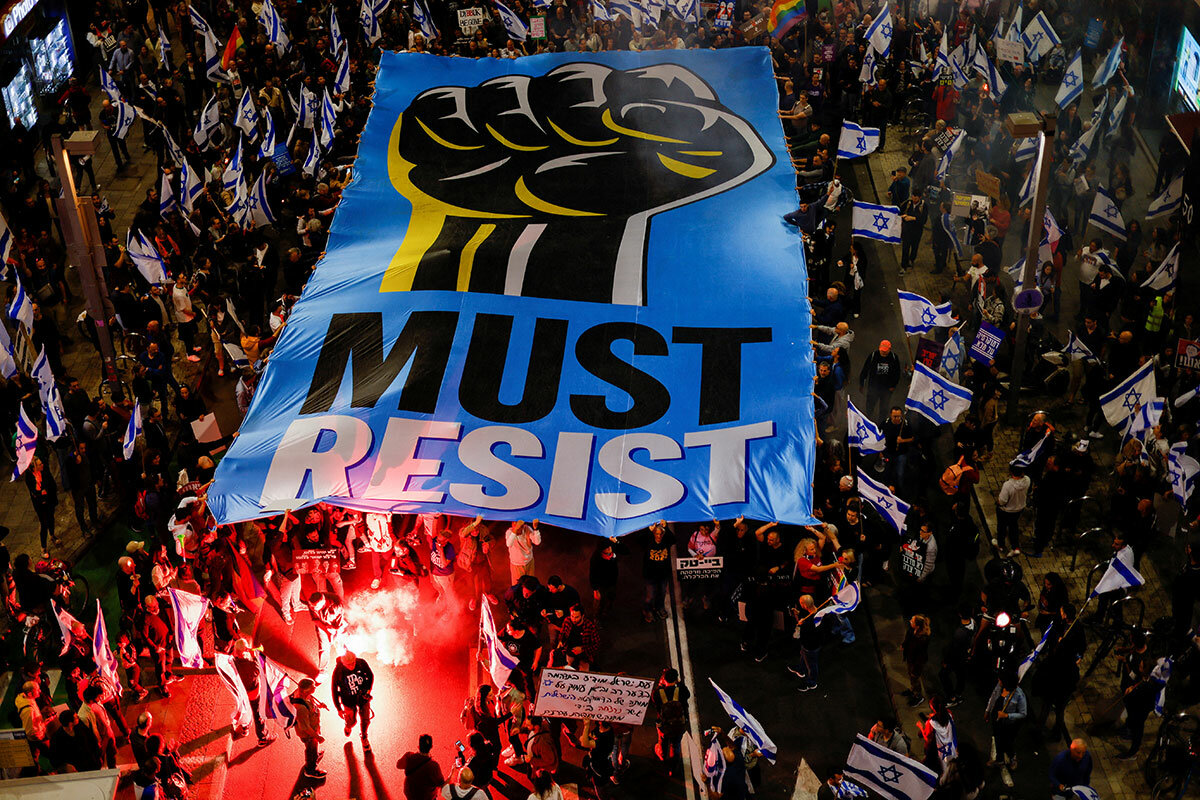
- Quick Read
- Deep Read ( 7 Min. )
-
By Neri Zilber Contributor
Elite combat veterans and high-tech workers in Israel, widely regarded as among the nation’s best and brightest, have become pivotal members of the pro-democracy movement protesting the hard-right government’s plans to “reform” the judicial system.
For many this is their first time taking to the streets, let alone refusing military call-ups in a country where such service is considered sacred. Yet the current danger to Israeli democracy is existential, they say, requiring unprecedented measures.
“For me and other protesters, the contract with the state was that it be Jewish and democratic, but the intent by this government is to turn it into Jewish only,” says Lt. Col. O., a reserve officer in a classified artillery unit.
An overwhelming proportion of the nation’s technology industry, which accounts for over 40% of all exports, is rebelling. Tech CEOs and firms have erected massive billboards, and in several high-profile cases even moved billions of dollars out of the country.
“It’s a global world, and the world won’t do business with a dictatorial state,” says Ohad, a tech executive. Yet Ohad, a reservist in the Intelligence Branch, says he won’t refuse duty if called, indicating the anguish around that issue. “You’re not defending a specific government,” he says. “You’re defending the nation, regardless of which idiot sits at the top.”
Israeli protesters: ‘Traitors’ – or best and brightest?
In years past, Israel’s long-serving prime minister, Benjamin Netanyahu, publicly took great pride in his country’s growing global stature, ascribing it to two main pillars: military power, as embodied in the Israel Defense Forces (IDF), and the technological innovation that gave the country a cherished nickname, “Startup Nation.”
Yet just over two months into his sixth term in office, Mr. Netanyahu faces a widespread revolt from precisely those segments of Israeli society.
Elite combat veterans and high-tech workers have become pivotal, and highly visible, members of the pro-democracy movement protesting against his government’s controversial plan to “reform” the country’s judicial system and undermine any check on executive power.
IDF reservists and the technology sector, widely regarded as among the best and brightest Israeli society has to offer, are not reflexive protesters. For many this is their first time signing petitions and taking to the streets, let alone refusing military call-ups in a country where such service is considered sacred.
Yet the current danger, as they see it, to Israeli democracy is existential and requires unprecedented measures.
Protest leaders and political analysts are clear-eyed that demonstrations that consistently have drawn hundreds of thousands of people nationwide for 10 straight weeks may not impress Mr. Netanyahu or his hard-right religious-nationalist coalition partners. But threatened economic and military damage may be the only leverage that can force him to back down from the legislation being rushed through parliament.
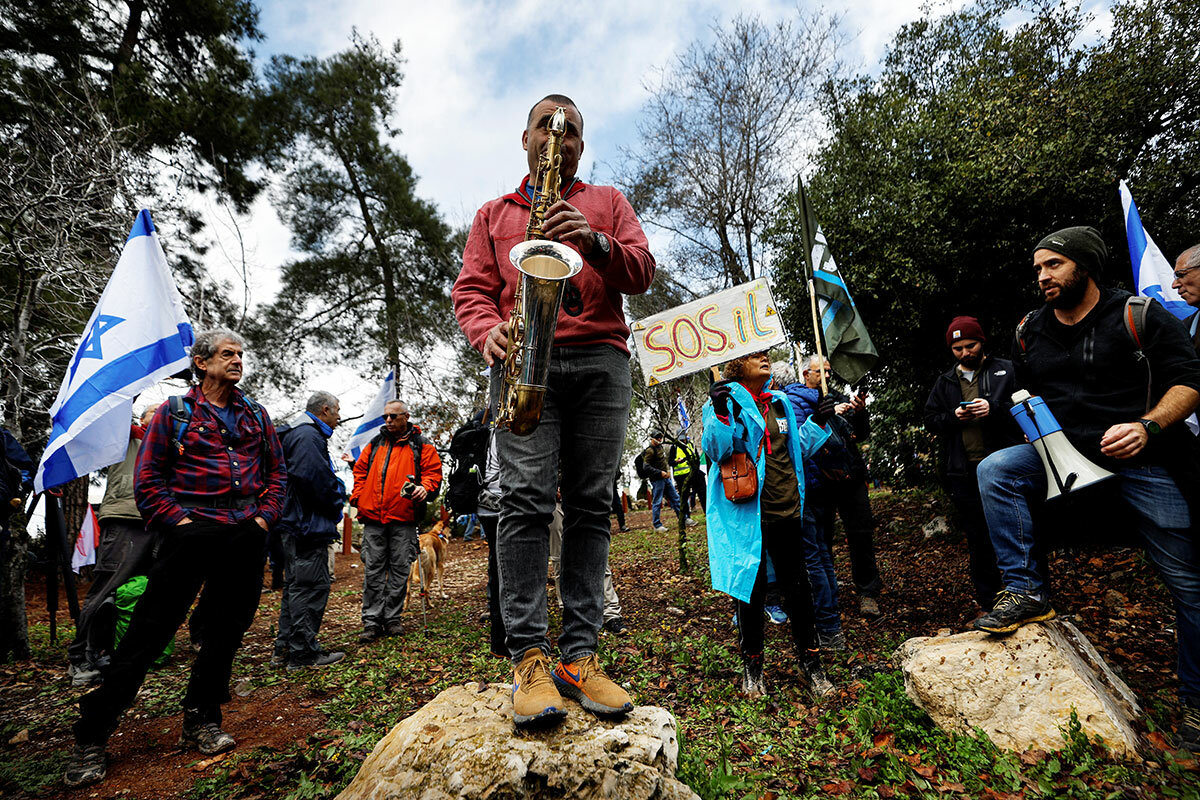
On Thursday, protests and strikes took place in more than 100 locales across the country in a self-styled “National Day of Resistance” that even disrupted the visit of U.S. Secretary of Defense Lloyd Austin. He had to meet with Mr. Netanyahu at the airport due to mass highway disruptions that also forced the Israeli leader to arrive by helicopter.
“Spreading like wildfire”
For many in Israel, the idea of reservists refusing military service is the most emotionally wrenching.
“For me and other protesters, the contract with the state was that it be Jewish and democratic, but the intent by this government is to turn it into Jewish only,” says Lt. Col. O., a veteran officer in a classified artillery unit who requested anonymity due to his sensitive military service and leadership in the reservist protest.
Lt. Col. O., who still volunteers for duty, helped organize the initial petition from his unit, which so far has garnered more than 1,000 signatures. Their sole request was that the government halt its legislative blitz and enter into real negotiations.
Countless other groupings of reservist protesters have sprouted up in recent weeks, totaling thousands of soldiers and officers, ranging from special forces commandos to cyber hackers, intelligence analysts to drone operators, and counter-terror operatives to combat pilots.
“We don’t have to serve in the reserves, it’s on a volunteer basis,” Lt. Col. O. explains, noting that only 1% of the population regularly does so. “But there was always faith that what we were doing was important, and that the country was worth it.”
In the most high-profile case so far, nearly an entire F-15 fighter jet reserve squadron declared early this week that it would boycott an upcoming training day. After entreaties by senior officers, the combat pilots arrived on base for a “dialogue” on the political crisis.
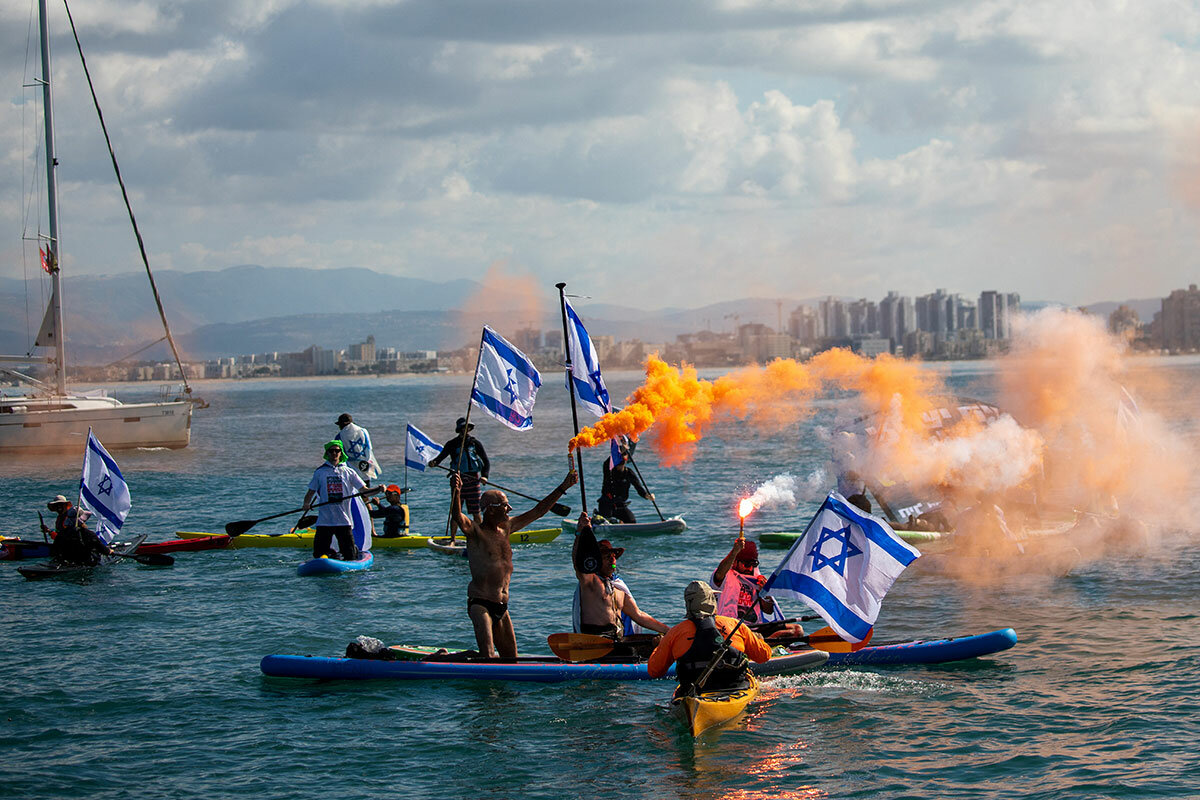
“What you’re seeing is the start of the process, and for the vast majority it’s not active refusal – yet,” says Amos Harel, defense analyst at the Haaretz daily. “It’s conditional: They’re saying that in future if these judicial ‘reforms’ are passed, then we will stop reporting for reserve duty.”
According to Mr. Harel, nothing on this scale has ever occurred among Israel’s citizen soldiers. “And it’s spreading like wildfire,” he adds.
The Air Force in particular is severely dependent on reservists, analysts say, with combat pilots and navigators still conducting active operations every week throughout the Middle East.
IDF Chief of Staff Herzi Halevy took the unprecedented step of meeting with Mr. Netanyahu this week to “express his concerns regarding the implications of reservists not reporting for duty,” according to one security source. Lt. Gen. Halevy has also met with several groups of reservists in recent days, saying that the security of the state rested with them and their ilk and that “refusal is a ‘red line.’ It should not be in the military protocol.”
He also condemned comments attacking the reservists as “traitors,” including by government ministers.
“Conditional pilots are not patriots. Not the salt of the earth. Not Zionists. Not the best of our boys,” Public Diplomacy Minister Galit Distel Atbaryan tweeted. Communications Minister Shlomo Karhi added, “The Jewish people will manage without you and you can go to Hell. The reform will move forward and advance.”
If the judicial overhaul is passed according to the government’s schedule, then as soon as next month the vast majority of reservist air crews will refuse to report for duty, according to Haaretz’s Mr. Harel.
“If someone in the IDF thinks they’ll have a reserve army after these laws are passed, then they’re living in a fantasy,” says Lt. Col. O.
The tech “miracle”
Mr. Netanyahu himself has so far not shown any inclination of backing down, dismissing the protesters as “anarchists,” even comparing them to rampaging Jewish settlers in the West Bank who burned homes in a Palestinian village last week. Mr. Netanyahu’s son and close adviser, Yair, even called the protest movement “domestic terrorism” and compared the tech sector to “Bolsheviks” leeching off the state.
In truth, the tech industry has been a main engine for Israel’s economic “miracle.” Just 10% of the national workforce, it accounts for over 40% of all exports, a quarter of all taxes, and some 15% of GDP, according to government figures.
Now an overwhelming proportion of that industry is rebelling, as tech CEOs and firms take a leading and very public role in the anti-government protest, from funding demonstrations to erecting massive billboards, and in several high-profile cases even moving billions of dollars out of the country.
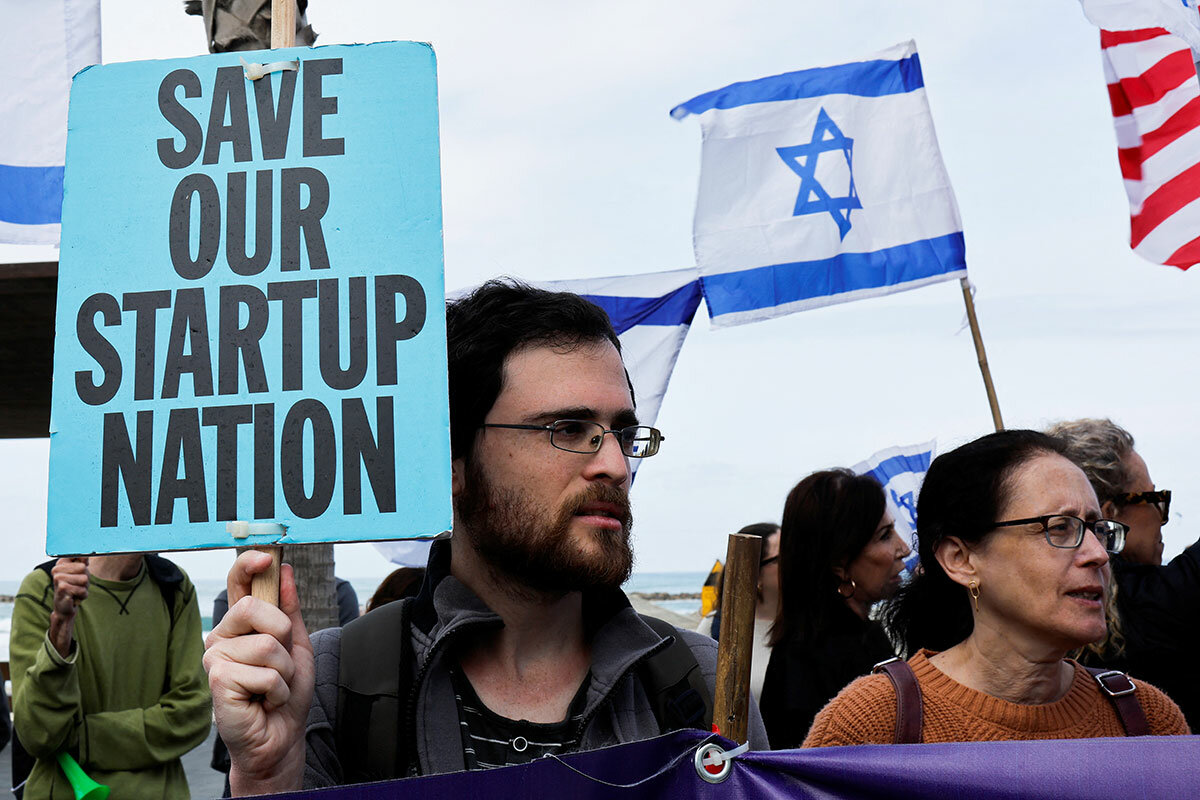
Tech analysts and executives have laid out a litany of concerns if the judicial overhaul comes to pass, including the courts’ abilities to uphold property rights and the civil liberties of minority groups like women, LGBTQ people, and Arab Israelis.
Many question whether, in a radically altered Israel, highly mobile tech workers will even want to stay here and raise families. The political upheaval has already created doubts in the minds of many global investors.
“Investors are very worried, and whenever there’s uncertainty, they stop to assess. In the case of Israel right now they’re saying, ‘Let’s wait,’” says one tech CEO prominent in the protest movement, asking for anonymity so as not to harm investor relations.
Another tech executive, Ohad, who has been present at recent demonstrations, is even more blunt: Tech in Israel has to look outward due to the small size of the local market. “It can’t exist as a ‘stand-alone industry,’” he says.
“It’s a global world, and the world won’t do business with a dictatorial state,” he adds. “The fear is that they’ll put Israel onto a blacklist, with sanctions. We’re not too far away from that in our current situation.”
Protesting, but still serving
Ohad, who also requested anonymity so as not to identify his firm, says there were “lots of layers of idiocy [on the part of the government] that leads to serious concerns” throughout the entire industry.
“You saw me and my colleagues last week demonstrating on a work day. The protest definitely represents how the sector feels.”
Interestingly, Ohad, a reservist in the IDF Intelligence Branch Special Operations Division, refused to sign the unit’s petition threatening to boycott duty.
“I’ll go to reserve duty if called,” he says. “You’re not defending a specific government or parliament, you’re defending the nation, regardless of which idiot sits at the top.”
For those now out on the streets, it seems, there are still certain norms that remain intact, despite their genuine anger. Yet even for someone like Ohad – a father of three, a law-abiding and patriotic citizen, an Israeli success story – those lines may be eroding.
“I’m not a big student of history, but it seems that the only protests that succeeded in the past are those that got out of control. The masses here aren’t going back home, and yet the government so far doesn’t even see us, even after weeks of protest. They haven’t stopped,” he says.
“I’m not an anarchist like they say, but at a certain point you can’t play by normal rules anymore.”

At Atlanta’s ‘Cop City,’ when does protest become terrorism?
The United States is gripped by sharp disagreement about when activism tips into lawlessness. This week, left-wing protesters in Atlanta were charged with terrorism, laying down a new marker in the debate.

- Quick Read
- Deep Read ( 8 Min. )
When protesters launched fireworks at Atlanta police and set a construction tractor ablaze Sunday, police say they crossed a line. This was “a coordinated attack on construction equipment and police officers,” a department spokesperson said.
The result: Nearly two dozen protesters were charged with domestic terrorism.
The subject of their ire is “Cop City” – a proposed police training facility in a city forest. And the clash is raising new questions in the national conversation about the line between activism and a loss of law and order.
Amid a surge in political violence, more states are expanding domestic terrorism laws – and using them. But the inability to clearly define what terrorism actually is makes applying them to situations like the one in Atlanta a fraught prospect. Left-wing violence is increasing, data suggests. But police can tend to focus on left-wing extremism while excusing right-wing extremism, some experts say.
Says Patrick Keenan of the University of Illinois College of Law: Laws intended to deal with international terrorism like 9/11 “are used more often in ordinary domestic crimes ... [so] they become regularized, normalized.”
At Atlanta’s ‘Cop City,’ when does protest become terrorism?

Within hours of arriving in the South River Forest last Sunday, Annie, a tall, dreadlocked woman from “another city” with multiple facial studs, hunkered down. Swarms of police were entering the forest, grabbing people from the shadows and cuffing them.
Moments before, she says, a friend she traveled with had gone off “to take a walk through the forest.” Prosecutors say he was on a mission of domestic terror. He was arrested along with 22 other activists that day and is now being held without bond and facing state charges that include domestic terrorism.
The protesters are here to stop what they dub Cop City – a proposed police training facility in the South River Forest, also known as the Weelaunee Forest. They are a mix of environmentalists, anti-police activists, and a loose confederation of like-minded groups. But police say they have gone beyond trespassing and are destroying property and using violence to push an ideology and endanger public safety. The Federal Bureau of Investigation is mulling federal charges.
“Everyone who comes here [to protest] knows full well they could catch a ‘DT,’” or domestic terrorism charge, says Annie, who refused to give her real name or allow a picture, concerned she would be targeted for arrest.
That is raising the stakes even higher, she adds. “Someone has died,” she says, referring to the police killing of a protester in January. “More could die.”
Americans have for years debated where to draw the line between law and order and the right to confront authority. But the use of domestic terrorism charges in Atlanta marks a new threshold. To many Americans, it’s a long overdue step to take a firmer stand against political unrest and violence. But to others, the move speaks to a dangerous push to silence dissent and criminalize protest.
In that way, the clash over “Cop City” is adding new questions to the national conversation: Where should the lines of terrorism be drawn in the name of public safety, and what does justice look like?
The fact “that all sorts of actions could be terrorism really speaks to the leaky nature of it as an idea,” says Dana Williams, a sociologist at California State University, Chico and co-author of “Anarchy & Society.” “Is the purpose to simply get people off the street who are a danger to public safety? Is it to punish people for very specific acts for which there is documentary evidence? Or is it to sort of suppress a movement that has some traction, where applying the word ‘terrorist’ helps to coat people’s perception of it?”
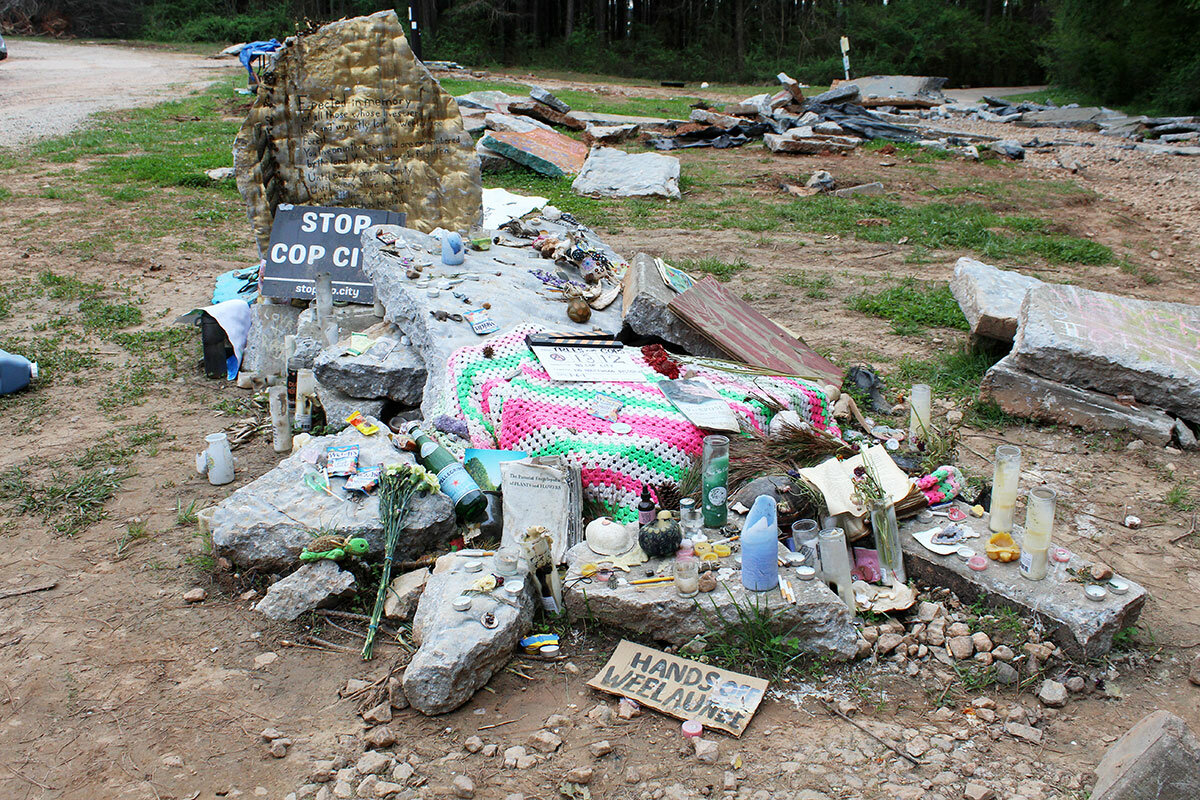
What happened in Atlanta
The latest domestic terrorism charges arose from events that happened on Sunday. Police released a video that showed a crowd of people emerging from the woods and spreading out into a fenced-off clearing. As the group advanced, a pair of police officers retreated behind a gate. They ducked as fireworks popped near them. Soon, construction equipment on the scene was burning.
Atlanta Police Department spokesperson Sgt. John Chafee said in a statement that those arrested “used the cover of a peaceful protest ... to conduct a coordinated attack on construction equipment and police officers.”
They join 19 others facing terrorism charges from previous incidents in the ongoing campaign. It’s the largest domestic terrorism sweep since a group of animal-liberation activists were indicted on terror charges in the 2000s.
The charges come amid a growth in political violence in the United States. All but eight U.S. states experienced at least one incident of domestic terrorism between 2010 and 2021, according to the Government Accountability Office, with the phenomenon growing by 357% since 2013. The FBI defines domestic terrorism as “violent, criminal acts committed by individuals and/or groups to further ideological goals stemming from domestic influences, such as those of a political, religious, social, racial, or environmental nature.”
Two percent of these attacks in 2019 occurred at demonstrations, the Center for Strategic and International Studies reported. The total committed by left-wing extremists grew almost 20 percentage points between 2020 and 2021 as demonstrations in cities like Portland, Oregon; Seattle; and Atlanta grew violent.
Georgia passed its domestic terror law after the 2015 killing of nine Black church parishioners in Charleston, South Carolina. New York used its law for the first time to boost charges against the racist-inspired shooter in Buffalo in 2022.
“More and more, state prosecutors are using domestic terrorism statutes for different crimes being committed, whether they’re extremist-related or school shootings,” says Javed Ali, a former Department of Homeland Security counterterrorism official.
When police and prosecutors are given new tools, they generally use them, adds Patrick Keenan, a professor at the University of Illinois College of Law in Champaign.
Laws intended to deal with international terrorism like 9/11 “are used more often in ordinary domestic crimes ... [so] they become regularized, normalized,” he says. “There is a risk to attaching the wrong label to crime.”
A view inside the protest camp
In Atlanta, one’s view of the charges often comes down to one’s views of the protesters.
At the South River trailhead along Constitution Road, it looks as if a zombie apocalypse just went down. Large piles of concrete indicate a torn-up bike path.
Amid the tangle of concrete and steel, there is a welcome tent with a young attendant. A drawing shows a burning police car, upside down, surrounded by the words “Resistance is love.”
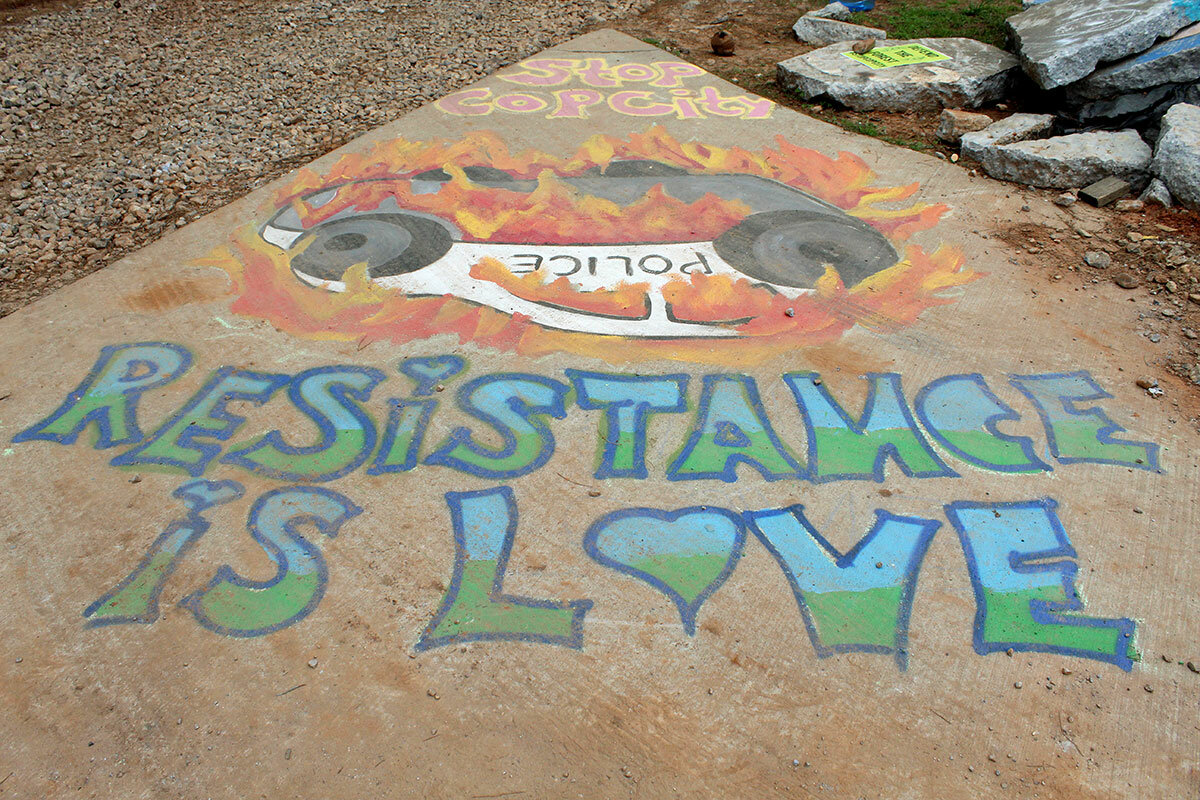
There is a memorial to “Tortuguita,” the nickname of Manuel Esteban Paez Terán, the slain activist. Police shot and killed him during a Jan. 18 operation to clear the site. They say Mr. Terán shot at police and they returned fire. Protesters contest that version of events. The Georgia Bureau of Investigation has begun a probe.
One young person with red hair festooned with ponytails listens wearily to a reporter’s question and then demurs an answer: “I just need to sit here and eat my chili, cool with you?”
The first defenders moved into the forest nearly two years ago. They set up camp in trees, and attempts by authorities to clear the camps have met with pushback.
“This forest is at the heart of it all,” says Annie, the activist.
In December, a prosecutor said a defendant inside a makeshift treehouse called for backup as police approached, and other activists appeared. She used a knife to cut a support rope for an arborist trying to dismantle her treehouse.
Police used pepper spray balls to try to shake protesters out of the trees. They were met with thrown rocks and bottles.
“If you use violence to basically get a policy changed, that is domestic terrorism,” the prosecutor said. “This isn’t just a bunch of kids playing in the woods.”
Ben, one of the activists, sees corporate interests holding voters by the scruff of the neck. The new police center is being funded by the privately funded Atlanta Police Foundation, which has raised suspicions about the motivations behind the new center.
“None of these terrorism charges are going to stick,” says Ben, who didn’t give his last name out of concerns about arrests and harassment. “This is about dividing us and suppressing us. They’re trying to scare us. It’s not going to work.”
The Center for Strategic and International Studies found that far-right extremists waged the most attacks (49%) in 2021, but attacks by anarchists and other far-left extremists grew from 23% in 2020 to 40% in 2021. Right-wing extremists are far more likely to use heavier weapons and take actions that end in fatalities; anarchists, by and large, don’t believe that destruction of property equals violence.
But, notes Mr. Ali, the former homeland security official: “You don’t have to kill anyone in order to conduct terrorism.”
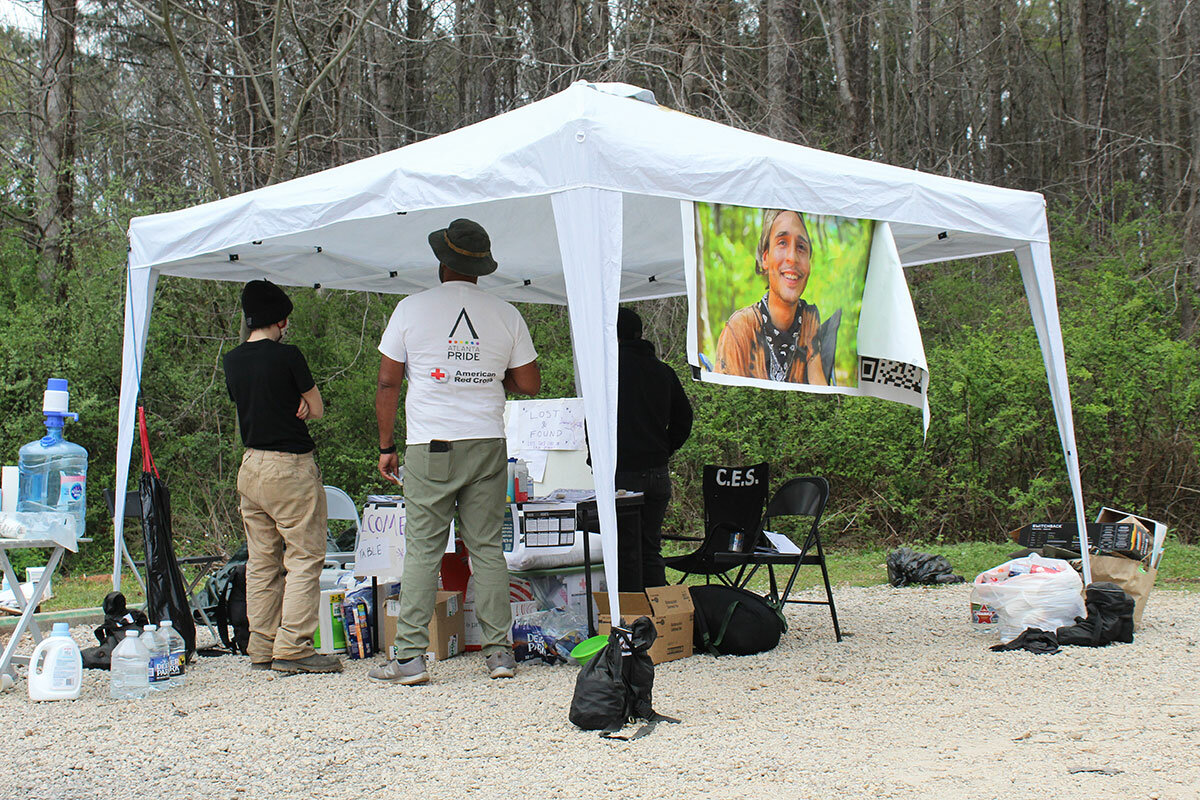
What measuring stick for terrorism?
The most recent incident in Atlanta “wasn’t just a peaceful protest. They turned toward violent action; it was planned and organized and choreographed to go a certain way,” says Mr. Ali, now a professor at the University of Michigan in Ann Arbor. “Yes, far-left extremism looks different than far-right stuff, but it doesn’t mean that the threat is zero in this country. You can’t be biased from a law enforcement or a domestic security perspective. If it looks like a duck, walks like a duck, it’s probably a duck.”
Yet others see a double standard. “When we talk about political violence, we also leave out ... police violence,” says Mike German, a former FBI agent who infiltrated right-wing extremist groups in the 1990s and is now a fellow at the Brennan Center for Justice.
In 2021, Mr. German testified to Congress that research shows how police actions incited riots during racial justice protests. He said law enforcement widely sees right-wing activists as “more mainstream” than left-wing ones. In his testimony, he pointed to instances of police declining to focus on white supremacist demonstrators while aggressively pursuing anti-fascists.
Ironically, the idea for the new police training center came about after the death of George Floyd, driven by the call for reform and better policing. But protesters worry that the facility will instead hone abusive crowd-control tactics. City officials have said few trees will have to be removed, and any that are will be replaced with plantings elsewhere.
Yet even as police brace for more conflict, lawmakers have begun to rethink the project. A firing range has already been pushed back from a residential area. Last week, the city announced a new citizen task force to further explore the idea.
In the meantime, both groups have only dug in deeper.
At the South River trailhead, a young female activist says she understands why activists are drawn to these woods – and why they vow to hold their ground.
“Everything that’s going on in this country can be found right here,” she says.
She urges a visitor to walk around the area to check out banners and camps, but to please respect activists’ wish to not be photographed, given their designation as violent extremists.
“Otherwise, just enjoy the forest,” she says, eyes crinkling above a mask.
Editor's note: Mike German's comments on police action against left- and right-wing groups have been clarified.

How Fukushima moms led charge for radiation data
A dozen years after a nuclear disaster in Fukushima, Japan, a group of concerned mothers show how engaging the public, rather than dismissing its fears, can foster a sense of trust and safety.

- Quick Read
- Deep Read ( 5 Min. )
-
By Takehiko Kambayashi Contributor
Twelve years ago, thousands of residents evacuated the Japanese port city of Iwaki as the Fukushima Daiichi power station spewed radioactive material over farmlands, rice paddies, and homes.
When yoga instructor Suzuki Kaori returned, her main concern was whether it was safe to raise her children amid the fallout. Reliable data was scarce – the plant operator and government were downplaying the disaster, and some public officials chastised worried mothers for acting “hysterical.” So she teamed up with other women to launch the Mothers’ Radiation Lab Fukushima. They had no formal scientific training, but they were determined to monitor radiation levels and “make the invisible threat visible,” says Ms. Suzuki.
The lab’s staff has since grown from two to 15, and they recently acquired two new state-of-the-art machines to help measure beta radiation in everything from homegrown produce to playground soil. The work has renewed importance as Japan plans to discharge radiation-tainted water into the sea later this year.
It’s one of many grassroots efforts helping restore trust following the nuclear disaster, says Shimizu Nanako, professor at the School of International Studies at Utsunomiya University.
“In many cases, it was women that spearheaded those activities to protect children,” she says.
How Fukushima moms led charge for radiation data

With its gigantic fish market, glass-walled aquarium, and gleaming shopping mall, the Japanese port city of Iwaki bears few visible scars of the massive tsunami that ripped through the area 12 years ago this week.
Yet the threat of radiation from the resulting nuclear meltdown still lingers.
Thousands of residents evacuated Iwaki in 2011 as the Fukushima Daiichi power station spewed radioactive material over farmlands, rice paddies, and homes. When yoga instructor Suzuki Kaori and other parents returned, their main concern was whether it was safe to raise their children amid the fallout. Reliable data was scarce – the plant operator and government were downplaying the disaster, and some public officials chastised concerned mothers for acting “hysterical” – so in November that same year, Ms. Suzuki teamed up with other women to launch the Mothers’ Radiation Lab Fukushima. They had no formal scientific training, but were determined to monitor radiation levels and “make the invisible threat visible,” says Ms. Suzuki.
The lab’s staff has since grown from two members to 15, and their work has renewed importance as residents brace for Japan’s controversial plan to discharge radiation-tainted water into the sea after treatment later this year.
It’s one of many grassroots efforts to restore trust following the Fukushima nuclear disaster, says Shimizu Nanako, professor at the School of International Studies at Utsunomiya University, adding that these mothers and other civil society groups have played a “valuable” role in advocating for community welfare.
“Besides nonprofits, much smaller community groups were also created to conduct study meetings about radiation and check radiation levels on routes to schools,” she says. “In many cases, it was women that spearheaded those activities to protect children.”
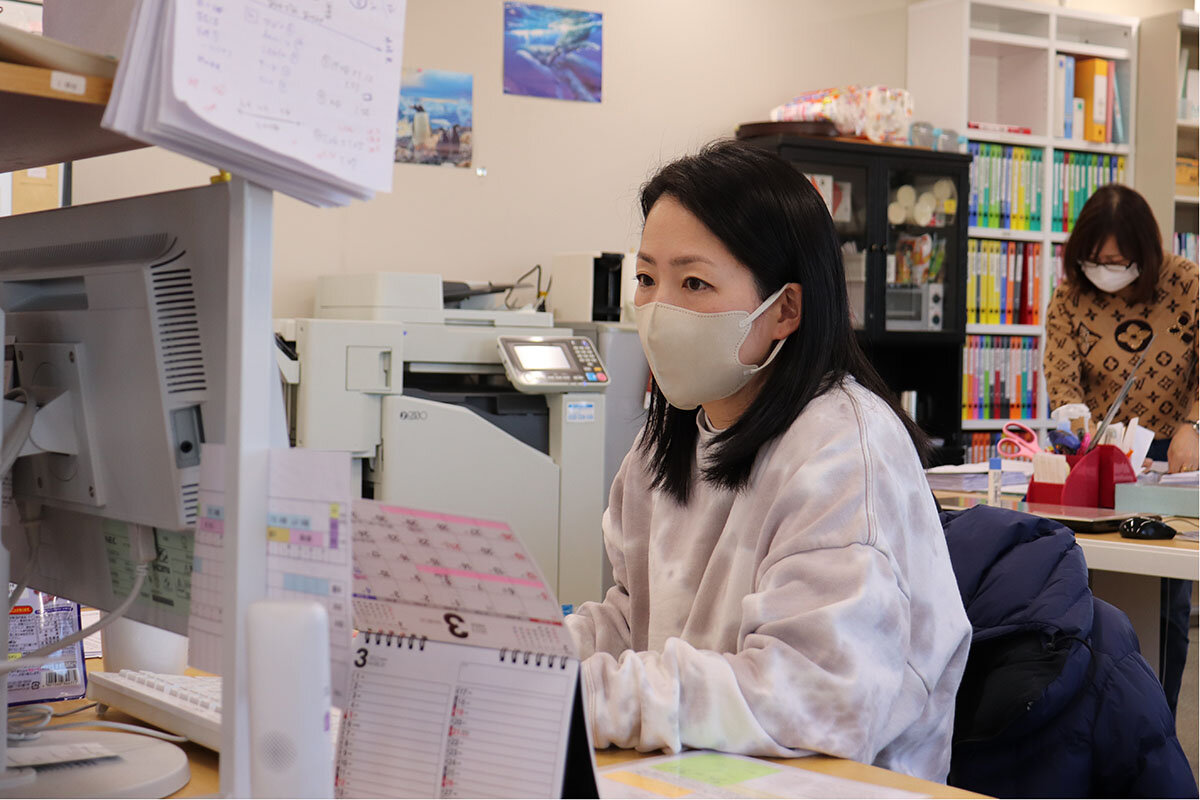
Power of data
The Fukushima prefectural government measures soil radioactivity in very limited areas near the plant – areas that don’t include Iwaki.
“At the beginning, we were doing the work just to protect the lives of our families,” recalls the lab director, but now they have their sights equally set on the distant future, hoping to leave future generations a fuller picture of the disaster. This requires the help of citizen scientists.
The lab – which is also called Tarachine, meaning “mother” – receives around 2,000 samples each year from the community, ranging from homegrown turnips to vacuum dust. They also measure soil and water radiation, publishing all their findings online.
In some cases, the mothers’ data assuages fear by revealing lower radiation levels than initially assumed. Other times, readings can trigger direct, immediate change. When they detect high levels of radiation in playgrounds, for example, the mothers contact local officials to send decontamination workers who remove the topsoil of the affected areas until radiation readings fall sharply.
In addition to gathering data that has been cited by academic journals, the group operates a clinic and has performed more than 15,000 thyroid cancer screenings throughout Fukushima and in neighboring prefectures. They also run a camp program designed to give kids a break from Fukushima and educate families about radiation safety.
That was Tanaka Noriko’s first introduction to the lab.
“I knew nothing about radiation before the nuclear disaster,” says Ms. Tanaka, who discovered that she was pregnant shortly before the nuclear plant suffered meltdowns and explosions. Like many other residents, she tried to avoid radiation by swapping local fish and produce – once a point of pride for the Iwaki community – for water and food imported from outside the prefecture.
Ms. Tanaka and her toddler eventually joined one of Tarachine’s earliest camp cohorts, and five years ago she decided to join the lab’s staff.
Having access to robust radiation data has allowed her to make informed decisions about her family’s safety, including that of her two primary school children.
“My children receive thyroid screening and take a urine test every year,” she says. “I won’t take them to parks where radioactivity is detected. We avoid mossy areas and side ditches where levels of radiation are likely higher.”

World-class research
To provide trustworthy data, the mothers regularly seek advice from experts like researcher Imanaka Tetsuji from the Institute for Integrated Radiation and Nuclear Science at Kyoto University, and Amano Hikaru, who used to work at the Japan Chemical Analysis Center and the Japan Atomic Energy Agency.
The lab hired Mr. Amano as a technical manager in 2015 when expanding radiation readings to include strontium-90 and tritium.
Tarachine mainly measures cesium-134 and cesium-137, which produce gamma rays, whereas strontium-90 and tritium emit beta rays. Measuring beta rays requires a different laboratory setting, as well as unique instruments and sample preparation, and some argued the work was “too dangerous for women,” Ms. Suzuki recalls. Medical researchers have linked strontium-90, which has a half-life of 28.8 years, to bone cancer and leukemia.
“One of my missions was to enable the mothers to measure beta rays safely,” says Mr. Amano. “The mothers were highly motivated to undertake the task. I was also impressed by their ability and meticulousness.”
Ms. Tanaka, who is in charge of measuring beta rays at the lab, says she understands and is undeterred by the risks.
“Somebody has to do this,” says the former pâtissier, adding that she wears safety goggles and thick gloves when she takes readings.
However, Ms. Shimizu says their work goes largely unrecognized in Japan, where civic activities are held in low regard, especially women-led initiatives. The country ranked 116th out of 146 countries in the 2022 Global Gender Gap Report by the World Economic Forum.
Still, Ms. Suzuki says the group’s success is a testament to the trust they’ve developed with local communities and to some degree across the country.
The lab does not receive – nor want – government subsidies, and it is instead funded mostly by donations from Japanese people throughout the country and overseas. Thanks to their support, the group recently acquired two state-of-the-art beta-reading machines costing $343,000 total. Mr. Amano says the mothers are, in effect, running a “world-class” lab.
“Donors understand our independent stance, and they want the money to be spent on children,” says Ms. Suzuki.
Editor’s note: The story has been updated to clarify the events of the Fukushima nuclear disaster.

Podcast
Oscars: Black Hollywood’s long climb continues
Who will leave the Academy Awards ceremony Sunday with a statuette? Bigger questions for commentator Ken Makin: Who got passed over? And what does that say about the film industry’s recognition of cultural clout?

You might think of the Academy Awards as being just an arcane industry game, the main outcomes of which are a pop of prestige and fuel for more box office earnings.
To commentator Ken Makin, they’re about much more.
“Award shows basically are proximity to power, to financial power, to earning potential,” Ken says on the Monitor’s “Why We Wrote This” podcast. He celebrates superstar Angela Bassett’s best supporting actress nomination (“Black Panther: Wakanda Forever”). But he sees a lost opportunity for more and better Black roles when a rising actor like Danielle Deadwyler (“Till”) is passed over, even for nomination, as happened this year.
In this episode, an updated encore of one he recorded in December, Ken says he’s disappointed that another powerful performance will go unnominated on the night of March 12: that of his fellow South Carolinian Viola Davis (“The Woman King”), who won her first Oscar back in 2016 (for “Fences”).
“Black people, we dictate the culture in so many ways,” Ken says, “particularly as it relates to entertainment. And that influence is undeniable.” His frustration: That influence is not yet getting, in his view, proportionate recognition from the institutions that hold power. Still, it’s the undeniable influence that also provides him some solace, and a sense that gains will keep coming.
“I remain hopeful,” Ken says. – Clayton Collins and Jingnan Peng
We encourage you to experience this episode as audio, if that’s an option for you. We also supply a transcript here.
‘The Envelope, Please’
Other headline stories we’re watching
(Get live updates throughout the day.)The Monitor's View
Spotting sprouts of democracy
- Quick Read
- Deep Read ( 3 Min. )
-
By the Monitor's Editorial Board
Plenty of Nigerians hoped that their recent presidential election would set a new high bar for democracy – not just for their country, but for all of Africa. Yet when it came time to vote, polling stations were disrupted by violence and ballot shortages, turnout was low, and the electronic system designed to prevent counting fraud faltered.
A familiar tale in many democracies, perhaps, but a misleading one. For the first time in nearly 20 years, there is evidence that “the world’s long freedom recession may be bottoming out,” according to Freedom House in its latest global survey. Political rights and civil liberties gained ground in 34 countries and lost in 35 – the narrowest gap since 2005. After tracking such data for a half-century, Freedom House finds “heartening proof that democratic progress is always possible.”
In Nigeria, the public’s frustration has not dampened a desire for change. Nearly 40% of Nigerians registered to vote were under age 35. Like most African youths, they are disrupting an entrenched political order.
Despite the ups and downs of democracy, Freedom House finds, the number of pro-democracy protests against autocratic rule shows “the people’s desire for freedom is enduring.” Nigeria is a prime example.
Spotting sprouts of democracy

Plenty of Nigerians hoped that their recent presidential election would set a new high bar for democracy – not just for their country, but for all of Africa. Yet when it came time to vote, polling stations were disrupted by violence and ballot shortages, turnout was low, and the electronic system designed to prevent counting fraud faltered. The ruling party candidate, Bola Tinubu, whose campaign slogan was “It’s my turn,” won with just 8.8 million votes in a country of 220 million people.
A familiar tale in many democracies, perhaps, but a misleading one. For the first time in nearly 20 years, there is evidence that “the world’s long freedom recession may be bottoming out,” according to Freedom House in its latest global survey. Political rights and civil liberties gained ground in 34 countries and lost in 35 – the narrowest gap since 2005. After tracking such data for a half-century, Freedom House finds “heartening proof that democratic progress is always possible.”
“So long as human beings remain true to their natural yearning for liberty, authoritarians will never be secure, and the global movement for democracy will never be defeated,” the report stated.
A few factors help explain the shift on rights and liberties. As countries have emerged from the pandemic, basic freedoms have been restored. Russia’s aggression in Ukraine has stirred democracies to a more vigorous defense of shared values. In every region, the report found, authoritarian regimes are facing growing popular backlashes against corruption, state violence, and controls on dissent.
The usual benchmarks for democratic progress are clean and fair elections with accepted results. The few examples in Africa underscore the continent’s potential for further democratic gains “if the virtuous circle of free elections and policy improvements is allowed to take hold.”
That is why Nigeria’s Feb. 25 election matters. The public’s frustration – women, for example, felt particularly excluded from seeking office – has not dampened a desire for change among its people, despite the low turnout. Nearly 40% of Nigerians registered to vote were under 35. Like most African youths, they are slowly disrupting an entrenched political order. Linked by social media, many reject political apathy.
“There is still something to be said about the palpable hope among Nigerians, especially the youth who took a leap of faith in the country, came out to vote, and in some cases, returned to polling units that had been attacked by thugs,” wrote Busayo Akinmoju, a Nigerian university student, in the The Republic magazine.
That persistence, he adds, signals “a renewed belief in the value of political participation. The youth got it right this time by showing up to make their voices heard, and in doing this, they moved the needle of change an inch in the right direction.”
In a country with few public services, “Nigerians’ self-organizing impulse is what has been preventing Nigeria from becoming a failed state,” according to a new Brookings report on Africa. “They go about their daily business ... trying to earn a living, get an education, create a career path, find a spouse, raise children, and just generally, make meaning of life.” The report recommends creating fewer big government programs and simply letting “non-state actors” continue to flourish.
Despite the ups and downs of democracy around the world, Freedom House finds, the number of pro-democracy protests against autocratic rule shows “the people’s desire for freedom is enduring.” Nigeria is a prime example.

A Christian Science Perspective
Each weekday, the Monitor includes one clearly labeled religious article offering spiritual insight on contemporary issues, including the news. The publication – in its various forms – is produced for anyone who cares about the progress of the human endeavor around the world and seeks news reported with compassion, intelligence, and an essentially constructive lens. For many, that caring has religious roots. For many, it does not. The Monitor has always embraced both audiences. The Monitor is owned by a church – The First Church of Christ, Scientist, in Boston – whose founder was concerned with both the state of the world and the quality of available news.
A freedom within
- Quick Read
- Read or Listen ( 1 Min. )
-
By Elizabeth Mata
When “the things of life seem / like too much,” we can lean into our true, spiritual nature as God’s children – inherently joyful and free – as this poem conveys.
A freedom within
The ocean beach speaks to me
of boundless, wide-open freedom –
ungrudging light blazes, dogs
romp with unscripted glee, kites
synchronize with the wind.At times the things of life seem
like too much, and no one is there
or too many are there and there’s no
room to move, and we long for release.Beach or not, there is a forever
place within where God, Soul – our
divine Parent – floods our hearts
with the light of Truth, unveiling
our spiritual nature as His, as Her,
reflection.As such, we are all pure gleams of
loveliness, receptivity, joy – moving
unhindered with Soul, with each other,
not confined by the surge of only
what the eye sees, the ear hears;
O Soul, show us Your bountiful,
cloudless glint.Then, like swells that roll in and sink
from sight in the sand, constraints
begin to ebb, then fade; our freedom
bursts forth.

Viewfinder
A fetching contestant

A look ahead
Thank you for joining us. Please come back Monday, when we take a look at persistent inflation, and how consumers and businesses are handling it.



